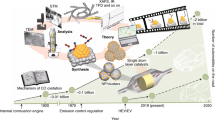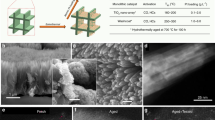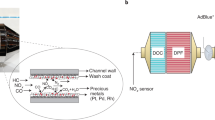Abstract
The development of three-way catalysts with improved low temperature activity is essential for automotive catalysis. Here, we show that solution atomic layer deposition (SALD) of titania or zirconia promoters on alumina supports lowers the light-off temperatures of rhodium-based catalysts by 50–150 °C compared to a commercial benchmark three-way catalyst. X-ray diffraction, scanning transmission electron microscopy–electron energy loss spectroscopy, diffuse reflectance UV–visible spectroscopy and X-ray absorption near edge structure results indicate that titania incorporated by SALD at one monolayer loading is present primarily as atomically disperse 5-coordinate Ti4+ species. These species persist after exposure to steam and corrosive gases at temperatures up to 960 °C. Zirconia incorporated onto alumina by SALD is present as few-nanometre oxide particles and supports a three-way catalyst activity that is superior to that of Rh on either alumina or zirconia. Our results show that molecularly precise synthesis can lead to robust promotion of precious metal activity and provide a promising path towards reducing emissions from gasoline vehicles.
This is a preview of subscription content, access via your institution
Access options
Access Nature and 54 other Nature Portfolio journals
Get Nature+, our best-value online-access subscription
$29.99 / 30 days
cancel any time
Subscribe to this journal
Receive 12 digital issues and online access to articles
$119.00 per year
only $9.92 per issue
Buy this article
- Purchase on Springer Link
- Instant access to full article PDF
Prices may be subject to local taxes which are calculated during checkout






Similar content being viewed by others
Data availability
The data presented here are available in raw or as-presented form (.csv,.xlsx,.jpg, or.pptx files) upon request to the corresponding author.
References
CACR Organization Committee Clean Air Car Race 1970: A Summary Report (Massachusetts Institute of Technology, 1971).
Host, R., Moilanen, P., Fried, M. & Bogi, B. Exhaust System Thermal Management: A Process to Optimize Exhaust Enthalpy for Cold Start Emissions Reduction SAE Technical Paper 2017-01-0141 (SAE, 2017).
Whitaker, P., Kapus, P., Ogris, M. & Hollerer, P. Measures to Reduce Particulate Emissions from Gasoline DI Engines SAE Technical Paper 2011-01-1219 (SAE, 2011).
Environmental Protection Agency. Control of air pollution from motor vehicles: tier 3 motor vehicle emission and fuel standards; final rule. Federal Register 79, 23414–23886 (2014).
Zammit, M. et al. Future Automotive Aftertreatment Solutions: The 150 °C Challenge Workshop Report (US Drive Workshop, 2012); https://www.pnnl.gov/main/publications/external/technical_Reports/PNNL-22815.pdf.
Gu, D. et al. Gold on different manganeseoxides: ultra-low-temperature CO oxidation over colloidal gold supported on bulk-MnO2 nanomaterials. J. Am. Chem. Soc. 44, 9572–9580 (2016).
Herzing, A. A., Kiely, C. J., Carley, A. F., Landon, P. & Hutchings, G. J. Identification of active gold nanoclusters on iron oxide supports for CO oxidation. Science 321, 1331–1335 (2008).
Haruta, M. et al. Low-temperature oxidation of CO over gold supported on TiO2, α-Fe2O3 and Co3O4. J. Catal. 144, 175–192 (1993).
Sachtler, W. M. H. & Ichikawa, M. Catalytic site requirements for elementary steps in syngas conversion to oxygenates over promoted rhodium. J. Phys. Chem. 90, 4752–4758 (1986).
Kip, B. J. et al. Preparation and characterization of vanadium oxide promoted rhodium catalysts. Appl. Catal. 33, 157–180 (1987).
Stevenson, S. A., Lisitsyn, A. & Knözinger, H. Adsorption of carbon monoxide on manganese-promoted rhodium/silica catalysts as studied by infrared spectroscopy. J. Phys. Chem. 94, 1576–1581 (1990).
Skoglundh, M. et al. Cobalt-promoted palladium as a three-way catalyst. Appl. Catal. B 7, 299–319 (1996).
Chen, H.-Y. & Chang, H. L. Development of low-temperature three-way catalysts for future fuel efficient vehicles. Johnson Matthey Technol. Rev. 59, 64–67 (2015).
Wu, Y. et al. Atomic layer deposition from dissolved precursors. Nano Lett. 15, 6379–6385 (2015).
Yan, W. et al. Surface sol–gel modification of mesoporous silica materials with TiO2 for the assembly of ultrasmall gold nanoparticles. J. Phys. Chem. B 108, 2793–2796 (2004).
Ramírez, J., Rayo, P., Gutiérrez-Alejandre, A., Ancheyta, J. & Rana, M. S. Analysis of the hydrotreatment of Maya heavy crude with NiMo catalysts supported on TiO2–Al2O3 binary oxides: effect of the incorporation method of Ti. Catal. Today 109, 54–60 (2005).
Damyanova, S., Grange, P. & Delmon, B. Surface characterization of zirconia-coated alumina and silica carriers. J. Catal. 168, 421–430 (1997).
Iengoa, P. et al. Preparation and properties of new acid catalysts obtained by grafting alkoxides and derivatives on the most common supports. Part II: grafting zirconium and silicon alkoxides on γ-alumina. Appl. Catal. A 170, 225–244 (1998).
Rohr, F., Lindvåg, O. A., Holmen, A. & Blekkan, E. A. Fischer–Tropsch synthesis over cobalt catalysts supported on zirconia-modified alumina. Catal. Today 58, 247–254 (2000).
O’Neill, B. J. et al. Catalyst design with atomic layer deposition. ACS Catal. 5, 1804–1825 (2015).
Onn, T. M. et al. High-surface-area ceria prepared by ALD on Al2O3 support. Appl. Catal. B 201, 430–437 (2017).
Onn, T. M. et al. Improved thermal stability and methane-oxidation activity of Pd/Al2O3 catalysts by atomic layer deposition of ZrO2. ACS Catal. 5, 5696–5701 (2015).
Getsoian, A.G., Theis, J.R. & Lambert, C.K. Catalyst for automotive emissions control. US patent 9,914,095B1 (2018).
Rappé, K.G. et al. Aftertreatment protocols for catalyst characterization and performance evaluation: low-temperature oxidation, storage, three-way, and NH3-SCR catalyst test protocols. Emiss. Control Sci. Technol. 6, 1–32 (2019).
Theis, J., Getsoian, A. & Lambert, C. The development of low temperature three-way catalysts for high efficiency gasoline engines of the future. SAE Int. J. Fuels Lubr. 10, 583–592 (2017).
Lui, Y. K.& Dettling, J. C. Evolution of Pd/Rh TWC Catalyst Technology SAE Technical Paper 930249 (SAE, 1993).
Digne, M., Sautet, P., Raybaud, P., Euzen, P. & Toulhoat, H. Use of DFT to achieve a rational understanding of acid-basic properties of γ-alumina surfaces. J. Catal. 226, 54–68 (2004).
Waqif, M., Bachelier, J., Saur, O. & Lavalley, J.-C. Acidic properties and stability of sulfate-promoted metal oxides. J. Mol. Catal. 72, 127–138 (1992).
Vayssieres, L., Persson, C. & Guo, J.-H. Size effects on the conduction band orbital character of anatase TiO2 nanocrystals. Appl. Phys. Lett. 99, 183101 (2011).
Monticone, S., Tufeu, R., Kanaev, A., Scolan, E. & Sanchez, C. Quantum size effect in TiO2 nanoparticles: does it exist? Appl. Surf. Sci. 162–163, 565–570 (2000).
Benedict, J. B., Freidorf, R., Trzop, E., Cogswell, J. & Coppens, P. Large polyoxotitanate clusters: well-defined models for pure-phase TiO2 structures and surfaces. J. Am. Chem. Soc. 132, 13669–13671 (2010).
Lin, C.-H., Huang, C.-N., Chen, S.-Y., Zheng, Y. & Shen, P. On the enhanced solute content, shape, defect microstructures and optical properties of Ti-doped γ-Al2O3 nanocondensates. J. Phys. Chem. C 113, 19112–19118 (2009).
Liu, X. et al. Ti3+ self-doped TiO2 − x anatase nanoparticles via oxidation of TiH2 in H2O2. Catal. Today 225, 80–89 (2014).
Aggarwal, R. L., Sanchez, A., Fahey, R. E. & Strauss, A. J. Magnetic and optical measurements on Ti:Al2O3 crystals for laser applications: concentration and absorption cross section of Ti3+ ions. Appl. Phys. Lett. 48, 1345 (1986).
Manzini, I., Antonioli, G., Lottici, P. P., Gnappi, G. & Montenero, A. X-ray absorption study of titanium coordination in sol-gel derived TiO2. Phys. B 208–209, 607–608 (1995).
Mountjoy, G. et al. XANES study of Ti coordination in heat-treated (TiO2)x(SiO2)1 − x xerogels. Chem. Mater. 11, 1253–1258 (1999).
Angelomé, P. C. et al. Mesoporous anatase TiO2 films: use of Ti K XANES for the quantification of the nanocrystalline character and substrate effects in the photocatalysis behavior. J. Phys. Chem. C 111, 10886–10893 (2007).
Farges, F., Brown, G. E. Jr. & Rehr, J. J. Ti K-edge XANES studies of Ti coordination and disorder in oxide compounds: comparison between theory and experiment. Phys. Rev. B 56, 1809–1819 (1997).
Coey, J. M. D. The crystal structure of Rh2O3. Acta Cryst. B26, 1876–1877 (1970).
de Resende, N. S., Eon, J.-G. & Schmal, M. Pt-TiO2-γ Al2O3 catalyst: I. Dispersion of platinum on alumina-grafted titanium oxide. J. Catal. 183, 6–13 (1999).
Wang, C.-B., Lin, H.-K. & Ho, C.-M. Effects of the addition of titania on the thermal characterization of alumina-supported palladium. J. Mol. Catal. A 180, 285–291 (2002).
Kim, M.-Y., Park, J.-H., Shin, C.-H., Han, S.-W. & Seo, G. Dispersion improvement of platinum catalysts supported on silica, silica–alumina and alumina by titania incorporation and pH adjustment. Catal. Lett. 133, 288–298 (2009).
Chattha, M. S. & Montreuil, C. N. High surface area, thermally stabilized titania automotive catalyst support. US patent 5,922,294 (1997).
Sivakumar, S., Sibu, C. P., Mukundan, P., Pillai, P. K. & Warrier, K. G. K. Nanoporous titania–alumina mixed oxides—an alkoxide free sol–gel synthesis. Mater. Lett. 58, 2664–2669 (2004).
Perera, S. & Gillan, E, G. High-temperature stabilized anatase TiO2 from an aluminum-doped TiCl3 precurso. Chem. Commun. 2005, 5988–5990 (2005).
Zhaobin, W., Qin, X., XieXian, G., Grange, P. & Delmon, B. Titania-modified hydrodesulfurization catalysts: II. Dispersion state and catalytic activity of molybdena supported on titania–alumina carrier. Appl. Catal. 75, 179–191 (1991).
Petkov, V., Holzhüter, G., Tröge, U., Gerber Th. & Himmel, B. Atomic-scale structure of amorphous TiO2 by electron, X-ray diffraction and reverse Monte Carlo simulations. J. Non-Cryst. Solids 231, 17–30 (1998).
Zhang, H., Chen, B., Banfield, J. F. & Waychunas, G. A. Atomic structure of nanometer-sized amorphous TiO2. Phys. Rev. B 78, 214106 (2008).
Levin, I. & Brandon, D. Metastable alumina polymorphs: crystal structures and transition sequences. J. Am. Ceram. Soc. 81, 1995–2012 (1998).
Samain, L. et al. Structural analysis of highly porous γ-Al2O3. J. Solid State Chem. 217, 1–8 (2014).
Krokidis, X. et al. Theoretical study of the dehydration process of boehmite to γ-Al2O3. J. Phys. Chem. B 105, 5121–5130 (2001).
Ferreira, A. R. et al. Direct comparison between two γ-Al2O3 structural models by DFT calculations. J. Solid State Chem. 184, 1105–1111 (2011).
Zope, B. N., Hibbitts, D. D., Neurock, M. & Davis, R. J. Reactivity of the gold/water interface during selective oxidation catalysis. Science 330, 74–78 (2010).
Kim, T. S., Gong, J., Ojifinni, R. A., White, J. M. & Mullins, C. B. Water activated by atomic oxygen on Au(111) to oxidize CO at low temperatures. J. Am. Chem. Soc. 128, 6282–6283 (2006).
Saavedra, J., Doan, H. A., Pursell, C. J., Grabow, L. C. & Chandler, B. D. The critical role of water at the gold–titania interface in catalytic CO oxidation. Science 345, 1599–1602 (2014).
Levin, M. E., Williams, K. J., Salmeron, M., Bell, A. T. & Somorjai, G. A. Alumina and titania overlayers on rhodium: a comparison of the chemisorption catalytic properties. Surf. Sci. 195, 341–351 (1988).
Fornasiero, P., Ranga Rao, G., Kašpar, J., L’Erario, F. & Graziani, M. Reduction of NO by CO over Rh/CeO2-ZrO2 catalysts: evidence for a support-promoted catalytic activity. J. Catal. 175, 269–279 (1998).
Chen, S.-L., Heck, R., Hu, Z. & Deeba, M. Catalytic converter system for internal combustion engine powered vehicles. US patent 20040166036A (2004).
Takahashi, R. et al. Structural study of mesoporous titania and titanium–stearic acid complex prepared from titanium alkoxide. J. Chem. Soc. Faraday Trans. 94, 3161–3168 (1998).
Getsoian, A., Theis, J. & Lambert, C. Sensitivity of three way catalyst light-off temperatures to air–fuel ratio. Emiss. Control Sci. Technol. 4, 136–142 (2018).
Hepburn, J. S., Dobson, D. A., Hubbard, C. P. & Otto, K. The Pulse Flame Combustor Revisited SAE Technical Paper 1996-10-2118 (SAE, 1996).
US Federal Govenment. Emission durability procedures for new light-duty vehicles, light-duty trucks and heavy-duty vehicles. 40 CFR Part 86. Fed. Regist. 69, 17531 (2004).
Kropf, A. J. et al. The new MRCAT (Sector 10) bending magnet beamline at the advanced photon source. AIP Conf. Proc. 1234, 299–302 (2010).
Ravel, B. & Newville, M. Athena, Artemis, hepaestus: data analysis for X-ray absorption spectroscopy using IFEFFIT. J. Synchrotron Radiat. 12, 537–541 (2005).
Acknowledgements
This research was sponsored by the US Department of Energy, Office of Energy Efficiency and Renewable Energy, Vehicle Technologies Office, Propulsion Materials Program under grant no. DE-EE0006845. Electron microscopy on the FEI Talos F200X STEM was provided by the Department of Energy, Office of Nuclear Energy, Fuel Cycle R&D Program and the Nuclear Science User Facilities. This research used resources of the Materials Research Collaborative Access Team at the Advanced Photon Source, a US Department of Energy Office of Science User Facility operated for the DOE by Argonne National Laboratory under contract no. DE-AC02-06CH11357. The authors thank K. Nietering for assistance with diffuse reflectance UV–vis spectroscopy, J. Wu and J. Kropf for assistance with X-ray absorption spectroscopy, and J. Hepburn, T. Toops, A. Binder, E. Kyriakidou, J. Schwank, G. Fisher, J. Hoard and C.-Y. Seo for useful discussions. This manuscript was co-authored by UT-Battelle, LLC, under contract no. DE-AC05-00OR22725 with the US Department of Energy (DOE).
Author information
Authors and Affiliations
Contributions
The project was conceived by C.K.L. and J.R.T. and supervised by C.K.L. Catalyst synthesis, DRUVS and XANES/EXAFS analyses were conducted by A.G. Catalyst performance was evaluated by J.R.T. and A.G. XRD analysis was conducted by W.A.P. and STEM-EDS by M.J.L. All authors contributed to writing and editing the manuscript.
Corresponding author
Ethics declarations
Competing interests
The authors declare no competing interests.
Additional information
Publisher’s note: Springer Nature remains neutral with regard to jurisdictional claims in published maps and institutional affiliations.
Supplementary information
Supplementary Information
Supplementary Tables 1–4; Supplementary Figs. 1–7
Rights and permissions
About this article
Cite this article
Getsoian, A.(., Theis, J.R., Paxton, W.A. et al. Remarkable improvement in low temperature performance of model three-way catalysts through solution atomic layer deposition. Nat Catal 2, 614–622 (2019). https://doi.org/10.1038/s41929-019-0283-x
Received:
Accepted:
Published:
Issue Date:
DOI: https://doi.org/10.1038/s41929-019-0283-x
This article is cited by
-
Reverse oxygen spillover triggered by CO adsorption on Sn-doped Pt/TiO2 for low-temperature CO oxidation
Nature Communications (2023)
-
Dispersion and stability mechanism of Pt nanoparticles on transition-metal oxides
Scientific Reports (2022)
-
Single atom catalysis poised to transition from an academic curiosity to an industrially relevant technology
Nature Communications (2021)
-
Opportunities and challenges in the development of advanced materials for emission control catalysts
Nature Materials (2021)
-
Surface oxygenation of multicomponent nanoparticles toward active and stable oxidation catalysts
Nature Communications (2020)



